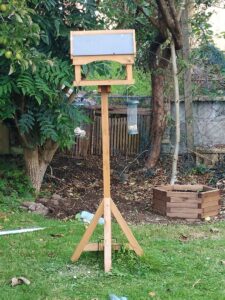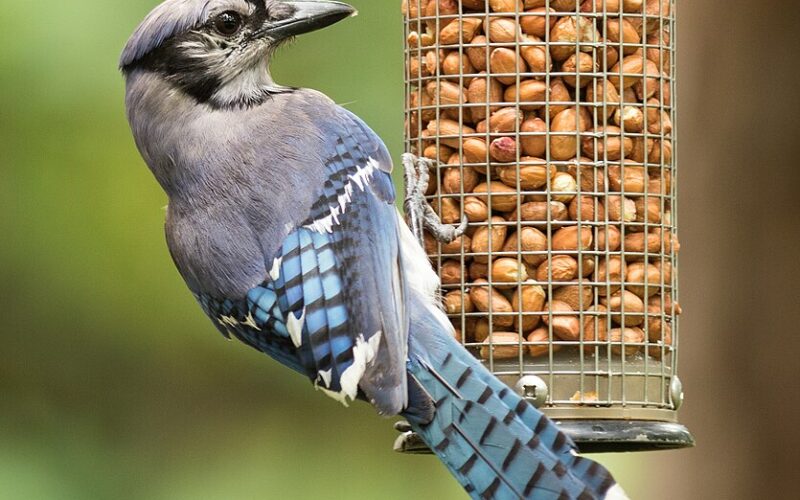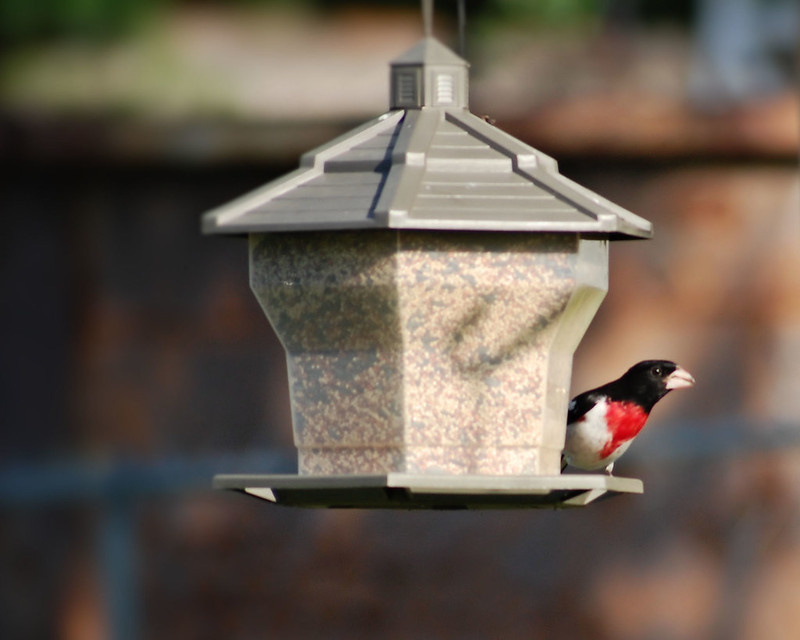Last Updated on January 3, 2024 by Greg Gillson
If you’ve never set up a bird feeder before, you may be worried that birds will not find it right away.
On the other hand, if you already have a bird feeder set up, your question often changes. How did they come so fast? How do the birds know I filled the feeder?
Birds find newly filled feeders using their excellent eyesight and listening to other birds fighting excitedly over food. They are constantly searching for food sources and investigate new objects in their territory. Once they find a feeder with seed, they keep going back to see if it is filled again.

Can wild birds smell bird seeds?
Experiments have revealed that most birds have a poor sense of smell. Their sense of smell is on par with humans or less sensitive. Both humans and birds have 3 conchae, the organs responsible for the sense of smell.
There are a few birds that do have a good sense of smell.
Turkey Vultures can locate carrion by smell.
Petrels can smell chemicals given off by plankton to find food in the oceans. These birds also use the sense of smell to find their correct nest burrows in colonies dug into sod on offshore islands.
Kiwi birds in New Zealand use smell to locate prey underground as they probe with their bills.
Parrots are said to have a good sense of smell.
But these are the exceptions.
Birds do not use smell to locate feeders or to tell if seeds or other food is present.

Then how do birds find bird feeders?
Birds primarily use vision, their sense of sight, to locate food.
Birds may see seeds that they recognize as food in your feeder. But to do so, they have to be pretty close.
Some birds of prey (hawks, eagles, falcons) have excellent visual acuity–they can detect prey very well–even from a long distance away.
Many birds, including hummingbirds and robins, at least, can see into the ultraviolet. That allows them to see different “colors” in what appears to human eyes to be a single color. But that doesn’t mean they can see bird seed any farther away than you or I can.
So to attract birds to a new feeder, you may spread some seed on the ground. They have a better chance of spotting the seed, then.
Birds recognize bird feeders the same way you do–through experience. A bird feeder is a small object shaped like a bowl or box next to the big square structure (house) where people live. It has bird food in it. Once they learn where to find food, they keep coming back.
Birds are very curious creatures. They explore their small territory on a constant look out for two things. Birds are constantly looking around to escape danger. Birds are constantly looking around to find food.
Birds also keep an eye out on their neighbors. Other birds, whether the same species or not, may alert them to dangers or food sources. If other birds are gathered around a small area, fluttering and hopping, it may be food!
But that’s not all. When a group of birds are eating they most always squawk and fight over the food. They make quite a loud noise sometimes when they are eating in such a group. If you listen, you can also hear birds at your feeder.
So hearing is the second way that birds locate bird feeders.

So how do birds know when I put out food?
Seeds come from plants. Seed eating birds must remember where those plants are and visit them regularly.
The same is true for bird feeders. Birds visit bird feeders regularly, perhaps several times during the day. They may not know how the food gets in the feeder. But they keep checking back.
On the other hand, birds may see you put food in the feeder. Or they may have learned that after people go near the feeder, there may be a new supply of food. Remember that birds keep an eye out for danger? Humans can be dangerous. So if you are out in your yard, the birds are keeping an eye on you!
So that’s it , then. Birds may see you fill the feeders. Or, they check back at feeders several times each day and find new food. Once a bird or two visits a newly-filled feeder other birds see and hear and follow them.
It can seem like birds have a special sense to just “know” when you have refilled your feeder. But they just watch, listen, and visit regularly.

Wrapping Up
So, the answer to how do birds know when I fill up the bird feeder is actually quite simple. They keep watch.
Birds have exceptionally keen eyesight, far surpassing that of humans. They can detect subtle color variations, ultraviolet light, and even perceive movement from great distances. This allows them to spot tiny insects, berries, and seeds amidst foliage. Some raptors like hawks have incredible binocular vision for pinpointing prey.
Frequently Asked Questions
How long will it take for birds to find a bird feeder?
The time it takes for birds to find a bird feeder depends on several factors, making it difficult to give a precise answer. Here’s what influences the discovery timeframe:
Feeder Placement: A feeder placed in a visible location with clear sightlines from surrounding areas gets noticed faster than one hidden by foliage or tucked away in a corner.
Activity in the area: If other birds are already visiting nearby feeders or natural food sources, it attracts new birds and encourages them to explore, potentially leading them to your feeder sooner.
Local bird populations: If your area has a diverse and abundant bird population, the chances of them finding your feeder quickly are higher.
Existing food sources: During times of plentiful natural food availability, like spring or summer, birds may not immediately rely on feeders and take longer to discover them.
How do I attract birds to my bird feeder?
Here are some tips to entice feathered friends.
Visibility: Place your feeder in a visible spot, preferably near shrubs or trees for cover but with clear sightlines to avoid predators.
Accessibility: Ensure birds can easily access the feeder without obstacles, avoiding dangling branches or direct sunlight.
Safety: Keep the feeder away from windows to prevent collisions and out of reach of predators like cats or squirrels.
Do birds tell other birds where food is?
Birds don’t use words or maps to tell each other where food is, but they do have ways of communicating food sources to their fellow feathered friends. Here are a few:
Calls and songs: Birds have a complex language of calls and songs that convey a variety of information, including the location of food. For example, a chickadee’s “chick-a-dee-dee” call can alert other chickadees to a good feeding spot.
Body language: Birds can also use their body language to signal the presence of food. For example, a robin that finds a patch of ripe berries may bob its head and flick its wings, inviting other robins to join in the feast.
Following each other: If one bird sees another bird feeding in a particular spot, it may follow that bird to see what it’s found. This is especially common among social birds, such as crows and jays.
More tips on feeding birds
5 Simple ways to attract more birds to your feeder
How often should you refill an empty bird feeder?
The two types of bird seed that attract the most birds!
7 kinds of bird feeders and the birds that like them
Confused as to how to set up your bird feeder? Let me help!
Is it ok to throw bird seed on the ground?











Great article, Greg.
Just put up a new feeder the other evening and the Black-Capped Chickadees found it at sunrise the next morning.
They were so loud that they attracted a House Finch, a Song Sparrow, and a Stellar's Jay all within 12 hours.
That's great, CJ. Thanks for sharing your experience.
I mix the bird seed with hard fat flour and peanut butter and then put it in the feeder. Takes them two day to eat. Is that OK
Seems like it should be okay.
Great article, thanks!
Thanks!
Excellent Article… Thanks!!
You are welcome!
Thank you it was very helpful I'm butting my bird house on my apartment balcony. I will put some on the ledge and ground to attract them to my bird feeder.
That sounds like it will work!
Great read 🙂 First two paragraphs summed up my experience so far with bird feeders perfectly. Looking forward to more of your work!
Thank you! There are over 200 articles on the site to keep you entertained and learning!
This was really cool 🙂 I noticed mine was empty this morning because it was so quiet outside. Sure enough I checked the feeder and it was dust lmao….it got quiet again when I went to fill it so I knew they were watching me. They were back 5mins later lol
Yes indeed!
When I feed my backyard birds I make a noice and they seem to recognize it as they come for it. A wood picker and chickadee even took food from my hand once after calling them.
We live out on a Pacific island and found your site after watching our feathered visitors gobble up sliced banana and thinking about how they regurgitate for their young. You answered a lot of the questions we were wondering about and confirmed our suspicions. Oh, and my Google search question had placed you up top. Happy birding.
Wow! When I refill the feeders the birds in my yard all watch me, even though I don't make any special sounds.
Thank you for visiting!
Wow, this bird niche site is a true haven for avian enthusiasts like myself! I'm constantly amazed by the vast array of captivating bird species showcased here. The articles are incredibly informative and well-researched, offering valuable insights into their behavior, habitats, and conservation efforts. The beautiful photographs accompanying each post truly bring these winged wonders to life. I appreciate how this site fosters a sense of community, allowing bird lovers to connect and share their experiences. The dedication and passion of the site's creators are evident in every aspect, making it an invaluable resource for anyone seeking to deepen their appreciation for our feathered friends. Keep up the outstanding work!"